4 Write an email to your best friend to share with them your problems during your teenage years (e.g., bullying, parental pressure, peer pressure, family problems, etc.) and ask for their advice, following these steps.
(Viết email cho người bạn thân nhất của bạn để chia sẻ với họ những vấn đề của bạn trong thời niên thiếu (ví dụ: bị bắt nạt, áp lực của cha mẹ, áp lực từ bạn bè, vấn đề gia đình, v.v.) và xin lời khuyên của họ, hãy làm theo các bước sau.)

Dear Harley,
My classmates receive many good marks in the final exam, but mine is just below the average level. I'm very worried whenever I think about that.
Can you give me some advice, please?
Yours sincerely,
Anna.
(Harley thân mến,
Các bạn cùng lớp của tôi nhận được nhiều điểm tốt trong kỳ thi cuối kỳ, nhưng của tôi chỉ ở dưới mức trung bình. Tôi rất lo lắng mỗi khi nghĩ đến điều đó.
Bạn có thể cho tôi một lời khuyên được không?
Trân trọng,
Anna.)

Các bài tập cùng chuyên đề
Bài 1 :
Writing
4. Match the causes of teen stress with the possible solutions. There may be more than one solution to a problem.
(Nối các nguyên nhân gây căng thẳng ở tuổi vị thành niên với các giải pháp khả thi. Có thể có nhiều hơn một giải pháp cho một vấn đề.)
|
Causes of teen stress (Nguyên nhân gây ra áp lực cho thiếu niên) |
Possible solution (Phương hướng giải quyết khả thi) |
|
1. peer pressure (áp lực đồng trang lứa) |
A. avoiding bullies wherever possible (tránh những kẻ bắt nạt ở bất cứ nơi nào có thể) |
|
2. too much schoolwork (quá nhiều bài tập ở trường) |
B. staying calm and relax (giữ bình tĩnh và thư giãn) |
|
3. spending too much time on social media (dành quá nhiều thời gian trên mạng xã hội) |
C. turning off smartphones (tắt điện thoại thông minh) |
|
4. bullying (bắt nạt) |
D. talking to teachers (nói chuyện với giáo viên) |
Bài 2 :
5. Write a paragraph (80 - 100 words) about the cause(s) of your stress and offer solutions.
(Viết một đoạn văn (80 - 100 từ) về nguyên nhân khiến bạn căng thẳng và đưa ra giải pháp.)
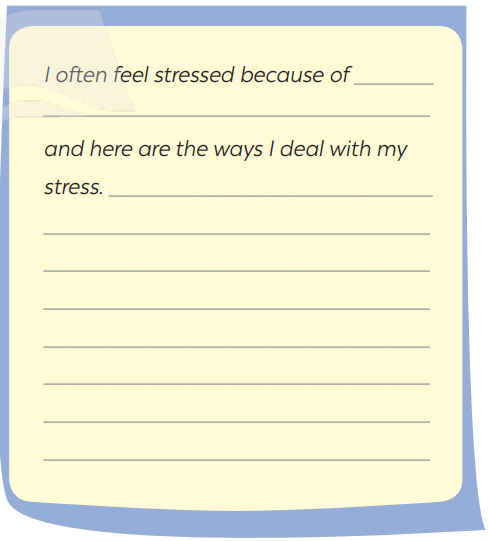
Bài 3 :
a. Read about writing problem and solution passages. Then, read Alex's passage again and answer the question. How many causes and solutions did Alex describe in his passage?
(Đọc về cách viết các đoạn văn có vấn đề và giải pháp. Sau đó, đọc lại đoạn văn của Alex và trả lời câu hỏi. Alex đã mô tả bao nhiêu nguyên nhân và giải pháp trong đoạn văn của mình?)
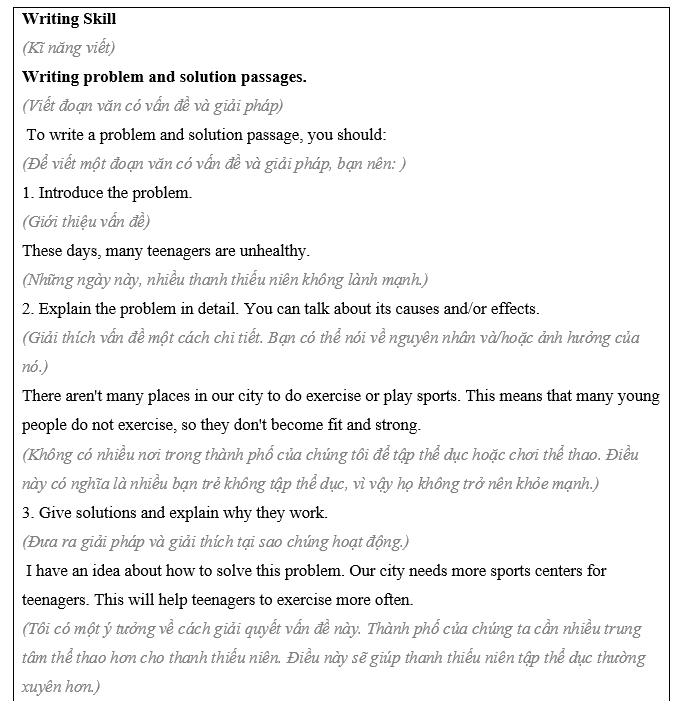

Bài 4 :
b. Read the sentences and write P for problem or S for solution.
(Đọc các câu và viết P cho vấn đề hoặc S cho giải pháp.)
Bài 5 :
Now, write a problem and solution passage about the problem you discussed in Speaking. Use the Writing Skill box and your speaking notes to help you. Write 80 to 100 words.
(Bây giờ, hãy viết một đoạn văn về vấn đề và giải pháp về vấn đề mà bạn đã thảo luận trong phần Nói. Sử dụng hộp Kỹ năng Viết và ghi chú nói của bạn để giúp bạn Viết 80 đến 100 từ.)
Bài 6 :
Write about your dream job. Use the questions below to help you. Write 80 to 100 words.
(Viết về công việc mơ ước của bạn. Sử dụng các câu hỏi dưới đây để giúp bạn. Viết 80 đến 100 từ.)
What's your dream job?
(Công việc mơ ước của bạn là gì?)
Why do you want to do it?
(Tại sao bạn muốn làm điều đó?)
What will you need to get the job?
(Bạn sẽ cần gì để có được công việc?)
What are some good things and bad things about the job?
(Một số điều tốt và điều xấu về công việc là gì?)
Bài 7 :
You are writing a passage with supporting information about a problem that teenagers have. Answer the questions.
(Bạn đang viết một đoạn văn với thông tin hỗ trợ về một vấn đề mà thanh thiếu niên gặp phải. Trả lời các câu hỏi.)
Bài 8 :
7 Compare your school life with Michael’s.
(So sánh cuộc sống học đường của bạn với Michael's.)
Bài 9 :
4 The diagram shows free-time activities teenagers like doing in their free time. Look and make sentences as in the example.
(Biểu đồ cho thấy các hoạt động trong thời gian rảnh rỗi mà thanh thiếu niên thích làm trong thời gian rảnh rỗi của họ. Nhìn và đặt câu như trong ví dụ.)
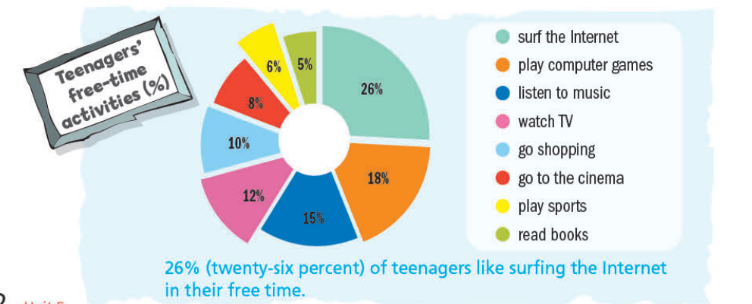
26% (twenty-six percent) of teenagers like surfing the Internet in their free time.
(26% (26 phần trăm) thanh thiếu niên thích lướt Internet khi rảnh rỗi.)
Bài 10 :
Task analysis
1 Read the task and complete the table.
(Đọc nhiệm vụ và hoàn thành bảng.)
This is part of an email from your English-speaking friend.
I moved to a new house, so I have to start at a new school. I'm really worried about it. What will happen if I can't make any new friends? Can you give me some advice?
Write an email to your friend giving him/her advice (about 80-100 words).

Bài 11 :
Model analysis
(Phân tích mẫu)
2 Read the model and complete the spidergram in your notebook.
(Đọc email và hoàn thành bảng trong sổ ghi chép của em.)
Hi Tom,
I'm sorry to hear that you're worried about starting at your new school. I've got some advice for you. Why don't you join an after-school club, such as a sports club? In this way, you'll meet students outside the classroom and it'll be easier to get to know them.
Another idea is to walk to school or take the school bus. Then, you'll meet other students on the way to school and you'll have the chance to talk to them.
I hope my advice helps.
Write back.
John
Bài 12 :
4 Use the ideas from Exercise 3 to write an email giving advice to your friend (about 80-100 words).
(Sử dụng các ý tưởng từ Bài tập 3 để viết một email đưa ra lời khuyên cho bạn của bạn (khoảng 80-100 từ).)
Bài 13 :
10 Your English friend is stressed about starting at a new school. Write an email giving him/ her advice (about 80-100 words). In your email, express your sympathy with his/her problem, give him/her two pieces of advice and the expected results, and express hope that he/she can solve his/her problem.
(Người bạn nói tiếng Anh của em đang căng thẳng về việc bắt đầu ở một trường học mới. Viết một email cho anh ấy/cô ấy lời khuyên (khoảng 80-100 từ). Trong email của em, hãy bày tỏ sự đồng cảm với vấn đề của anh ấy/cô ấy, cho anh ấy/cô ấy hai lời khuyên và kết quả mong đợi, đồng thời bày tỏ hy vọng rằng anh ấy/cô ấy có thể giải quyết vấn đề của mình.)
Bài 14 :
1. Work in pairs. Choose the best way to start your email messages in situations 1-3.
(Làm việc theo cặp. Chọn cách tốt nhất để bắt đầu email của bạn trong tình huống 1-3.)
1. ____ You are asking a close friend for advice.
2. ____ You are asking someone you don’t know very well for some advice.
3. ____ You are asking an adult who you have never met for some advice.
a. Dear Mrs. Henderson
b. Hi Holly,
c. Dear Holly,
Bài 15 :
2. Read the three emails below. Which one is more formal? Which one is least formal?
(Đọc ba email dưới đây. Cái nào trang trọng hơn? Cái nào là ít trang trọng nhất?)
1.
Dear Holly,
My sister and I are very close and we are nearly the same age. We do everything together, but sometimes I feel my friends like me a bit more than my sister. So recently my friends invited me to a party, but they didn’t invite my sister, and she really wants to come too. I would feel bad if I went there without her. We do almost everything together. What should I do?
Could you give me some advice, please?
Best,
Susan
2.
Hi Holly,
I loves shoes. My mum thinks I have too many. I have about 15 pairs. But what my mum doesn’t understand is most of my friends have over 20 pairs. So the problem is I want these new shoes, but my mom won’t buy them for me. I’m not sure if she doesn’t like them, or they’re too expensive or that I already have a lot of shoes.
Any advice?
Matt
3.
Dear Mrs. Henderson,
I was wondering if you could offer me some advice. Every weekend my friends get together and go to the beach. I really want to go too, but my cousin comes over and we end up staying at my place. This weekend my friends invited me again. I feel if I say no then they won’t ever invite me again. But my cousin doesn’t want to go, and she doesn’t want me to go, either.
Yours sincerely,
Christie
Bài 16 :
3. Read the emails again. Underline the different expressions used for asking for advice.
(Đọc lại các email. Gạch chân những cách diễn đạt khác nhau được sử dụng để xin lời khuyên.)
|
Writing (Viết) |
Formal and informal language (Ngôn ngữ trang trọng và không trang trọng) |
|
Formal (Trang trọng) Dear + (name), (Kính gửi + (tên),) Dear Mr. / Mrs. / Ms. / Miss. (Kính gửi Ông/Bà/Bà/Cô.) Yours sincerely, (Trân trọng,) |
Neutral (Trung lập) Best, (Điều tuyệt nhất,) Informal (Thân mật ) Hi, (Chào,) Hello, (Xin chào,) |
Bài 17 :
4. Fill in the blanks to complete the email to a close friend. Use the best choice (a or b) for each blank below.
(Điền vào chỗ trống để hoàn thành email gửi cho một người bạn thân. Sử dụng sự lựa chọn tốt nhất (a hoặc b) cho mỗi chỗ trống dưới đây.)
|
(1) _______, (2) _________________________________________________. I would like to invite some friends over next weekend, but I don’t know what type of food to serve or what type of activities we should do. The last time I held a party it wasn’t very fun. I think you might have some good ideas. (3) _______ |
1.
a. Dear Mr. Trinh
b. Hello Minh
2.
a. Could you give some advice, please?
b. I was wondering if you could offer me some advice.
3.
a. Yours sincerely,
Mai
b. Best,
Mai
Bài 18 :
5. Write an email (80-100 words) to an advice columnist at Teenagers Speak Magazine to ask for advice on your problems. Choose one of these problems and use some of the words.
(Viết một email (80-100 từ) cho người phụ trách chuyên mục tư vấn tại Tạp chí Teens Speak để xin lời khuyên về các vấn đề của bạn. Chọn một trong những vấn đề này và sử dụng một số từ.)
Problem 1: You don’t know who to invite to a birthday party.
(Vấn đề 1: Bạn không biết mời ai đến dự tiệc sinh nhật.)
Friends, invite, birthday party, beach, food, games, fun
(Bạn bè, mời, tiệc sinh nhật, bãi biển, đồ ăn, trò chơi, niềm vui)
Problem 2: You want a new tablet.
(Vấn đề 2: Bạn muốn có một chiếc máy tính bảng mới.)
Mum, tablet, old tablet, broken, money, extra work, promise
(Mẹ, máy tính bảng, máy tính bảng cũ, hỏng, tiền, việc làm thêm, lời hứa)
Bài 19 :
WRITING
5. Your class is holding a writing test. Work in groups of four. Write an email of 80-100 words to describe a problem you (or other teenagers) face and ask for advice. Swap emails with another group and answer their email.
(Lớp của bạn đang tổ chức một bài kiểm tra viết. Làm việc trong nhóm bốn. Viết một email từ 80-100 từ để mô tả một vấn đề mà bạn (hoặc những thanh thiếu niên khác) gặp phải và xin lời khuyên. Trao đổi email với nhóm khác và trả lời email của họ.)
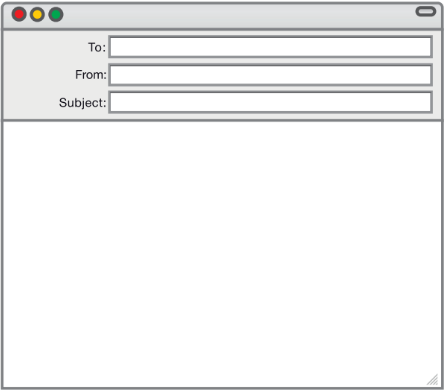
Bài 20 :
1. Make sentences using the words and phrases below. You can add necessary words.
(Đặt câu sử dụng các từ và cụm từ dưới đây. Bạn có thể thêm các từ cần thiết.)
1. Teenagers / should / play / sport / keep fit.
2. Teens / may feel / stressed / when / classmates / do better / than them / school.
3. Some teens / participate / school clubs / make / new / friends.
4. Some teens / feel / pressure / because / they / want / fit / a group.
5. main causes / teen stress / include / peer pressure / schoolwork pressure / pressure from parents.
Bài 21 :
3. Use the mind map below to write a paragraph of about 80 - 100 words about how your classmates should deal with stress.
(Sử dụng bản đồ tư duy dưới đây để viết một đoạn văn khoảng 80 - 100 từ về cách các bạn cùng lớp của bạn nên đối phó với căng thẳng.)
Bài 22 :
6. Complete the table about you. Then ask your family members about what makes them sad. Then fill in the table.
(Hoàn thành bảng về bạn. Sau đó hãy hỏi những người trong gia đình bạn xem điều gì khiến họ buồn. Sau đó điền vào bảng.)
|
You |
- get bad marks - ____________________ |
|
Your family member(s) - Father / Mother - Sister / Brother |
- ____________________ - ____________________ |
Bài 23 :
1 Rearrange the following sentences to make an email.
(Sắp xếp lại các câu sau để tạo thành một email.)
Bài 24 :
2 Lyn is writing an email to her close friend. Circle the best choice (a or b) for each blank below to help her finish it.
(Lyn đang viết email cho người bạn thân của cô ấy. Hãy khoanh tròn lựa chọn đúng nhất (a hoặc b) cho mỗi chỗ trống bên dưới để giúp em hoàn thành câu đó.)
.
I'm so sad right now. I like drawing and painting, but my parents don't understand it. They want me to focus more on other subjects like maths and science. I have already had an argument with them. ?
.
Lyn
(Bây giờ tôi đang rất buồn. Tôi thích vẽ và vẽ tranh nhưng bố mẹ tôi không hiểu điều đó. Họ muốn tôi tập trung nhiều hơn vào các môn học khác như toán và khoa học. Tôi đã tranh cãi với họ rồi)
Bài 25 :
3 Match each of the following problem (1-5) to its suitable example (a-e).
(Hãy ghép mỗi vấn đề sau (1-5) với ví dụ phù hợp (a-e).)
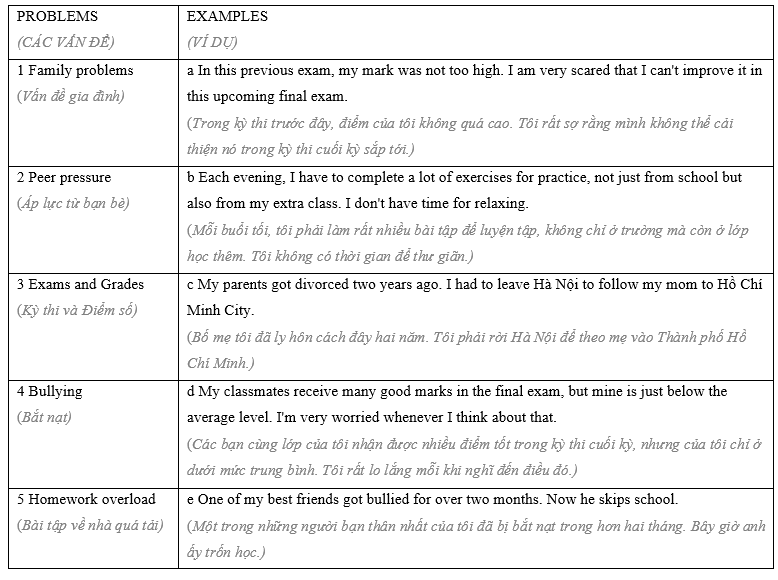
Bài 26 :
6 Complete an email (80-100 words) to Holly, an advice columnist, at Be My Friend Magazine to tell her about your teenage problem and ask her for advice.
(Hoàn thành một email (80-100 từ) gửi Holly, người phụ trách chuyên mục tư vấn của Tạp chí Be My Friend để kể cho cô ấy nghe về vấn đề tuổi teen của bạn và xin cô ấy lời khuyên.)
Bài 27 :
9. Write a story for an international teen magazine about a natural disaster or an accident you experienced (about 80-100 words).
(Viết một câu chuyện cho một tạp chí quốc tế dành cho thanh thiếu niên về một thảm họa thiên nhiên hoặc một tai nạn mà bạn đã trải qua.)
Bài 28 :
Write full sentences using the prompts. Then, number the sentences (1-4) to match them with the parts of a problem and solution passage. Use the skill box to help you.
(Viết câu đầy đủ bằng cách sử dụng các gợi ý. Sau đó, đánh số các câu (1-4) để nối chúng với các phần của đoạn văn có vấn đề và giải pháp. Sử dụng hộp kỹ năng để giúp bạn.)
1. believe / if / teenagers / yoga / bed earlier, / less stressed
_______________________________________________________
2. teenagers / too / stressed
_______________________________________________________
3. this / means / teenagers / don’t / study / well
_______________________________________________________
4. teenagers / should / yoga. / should / also / bed / earlier
_______________________________________________________
Bài 29 :
Choose a problem and complete the table.
(Chọn một vấn đề và hoàn thành bảng.)
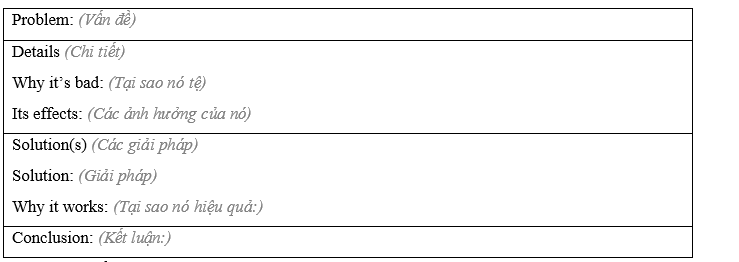
Bài 30 :
Now, write a problem and solution passage about your chosen problem. Use the Writing Skill box and your notes to help you. Write 80 to 100 words.
(Bây giờ, hãy viết một đoạn văn có vấn đề và giải pháp về vấn đề bạn đã chọn. Sử dụng hộp Kỹ năng viết và ghi chú của bạn để giúp bạn. Viết 80 đến 100 từ.)

















